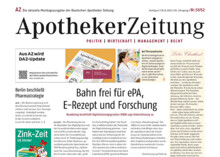
- DAZ.online
- DAZ / AZ
- DAZ 9/2012
- Literaturverzeichnis: ...
Pharmako-logisch!
Literaturverzeichnis: Pharmako-logisch! – Suchtkrankheiten
Literatur
[1] Batra A: Treatment of tobacco dependence. Dtsch Arztebl Int 2011; 108: 555-64.
[2] Benedetti F, Amanzio M, Rosato R, et al.: Nonopioid placebo analgesia is mediated by CB1 cannabinoid receptors. Nat Med 2011; 17: 1228-30.
[3] De Biasi M, Dani JA: Reward, addiction, withdrawal to nicotine. Annu Rev Neurosci 2011; 34: 105-30.
[4] Hoell I, Havemann-Reinecke U: [Pregnant opioid addicted patients and additional drug intake. Part I. Toxic effects and therapeutic consequences]. Med Monatsschr Pharm 2011; 34: 363-74; quiz 75-6.
[5] Kenny PJ: Reward mechanisms in obesity: new insights and future directions. Neuron 2011; 69: 664-79.
[6] Li TK, Volkow ND, Baler RD, et al.: Adverse effects of cannabis. Prescrire Int 2011; 20: 18-23.
[7] Li TK, Volkow ND, Baler RD, et al.: The biological bases of nicotine and alcohol co-addiction. Biol Psychiatry 2007; 61: 1-3.
[8] Lobmaier P, Gossop M, Waal H, et al.: The pharmacological treatment of opioid addiction--a clinical perspective. Eur J Clin Pharmacol 2010; 66: 537-45.
[9] Luscher C, Malenka RC: Drug-evoked synaptic plasticity in addiction: from molecular changes to circuit remodeling. Neuron 2011; 69: 650-63.
[10] Mineur YS, Abizaid A, Rao Y, et al.: Nicotine decreases food intake through activation of POMC neurons. Science 2011; 332: 1330-2.
[11] Murnane KS, Howell LL: Neuroimaging and drug taking in primates. Psychopharmacology (Berl) 2011; 216: 153-71.
[12] Potenza MN, Sofuoglu M, Carroll KM, et al.: Neuroscience of behavioral and pharmacological treatments for addictions. Neuron 2011; 69: 695-712.
[13] Ross S, Peselow E: The neurobiology of addictive disorders. Clin Neuropharmacol 2009; 32: 269-76.
[14] Schlaepfer IR, Hoft NR, Ehringer MA: The genetic components of alcohol and nicotine co-addiction: from genes to behavior. Curr Drug Abuse Rev 2008; 1: 124-34.
[15] Stead LF, Perera R, Bullen C, et al.: Nicotine replacement therapy for smoking cessation. Cochrane Database Syst Rev 2008: CD000146.
[16] Sulzer D: How addictive drugs disrupt presynaptic dopamine neurotransmission. Neuron 2011; 69: 628-49.
[17] Tsoi DT, Porwal M, Webster AC: Interventions for smoking cessation and reduction in individuals with schizophrenia. Cochrane Database Syst Rev 2010: CD007253.
[18] Ungless MA, Argilli E, Bonci A: Effects of stress and aversion on dopamine neurons: implications for addiction. Neurosci Biobehav Rev 2010; 35: 151-6.
[19] Arzneimittelkommission ddÄ: Tabakabhängigkeit. Arzneiverordnung in der Praxis 2010, November; Band 37.
[20] Bonnet U, Scherbaum N: Evidenzbasierte Behandlung der Cannabisabhängigkeit. Dtsch Arztebl Int 2005; 102: 3334-41.
[21] Martini B: Sucht: Baclofen bei Alkoholabhängigen mit Leberzirrhose. Med Monatsschr Pharm 2008; 31.
[22] Saussele T: Opioid-Abhängigkeit: Buprenorphin-Implantat für die Behandlung der Opioid-Abhängigkeit. Med Monatsschr Pharm 2011; 34: 141.





















0 Kommentare
Das Kommentieren ist aktuell nicht möglich.